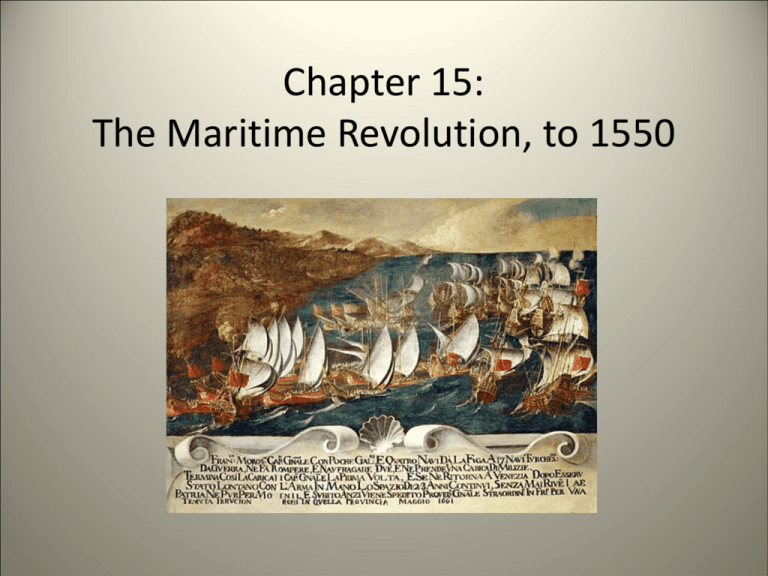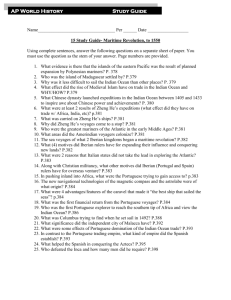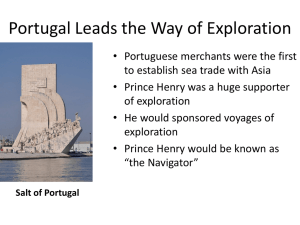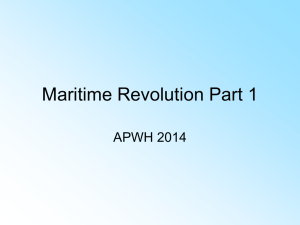Chapter 15: The Maritime Revolution
advertisement

Chapter 15: The Maritime Revolution, to 1550 The Pacific Ocean • Over about 1500 years, peoples originally from Malaysia crossed ocean & settled in Polynesia to establish colonies • Observed stars, ocean currents & evidence of land The Indian Ocean • • • Malayo-Indonesians colonized Madagascar through 15th century Arabs used monsoon winds to establish trade routes in Indian Ocean. Ming dynasty sponsored voyages to Indian Ocean between 1405-1433 – fleets of over 60 large “treasure ships” & hundred of smaller support vessels The Indian Ocean • • • • • • • 1415, E. Africa’s cities sent delegations to China Zheng He, led voyages to Africa traded luxuries (silk and precious metals) stimulated diplomatic relations with various African and Asian states not profitable inspired opposition in court ended in 1433 The Atlantic Ocean • During warmer early Middle Ages, Vikings navigated by stars & seas • Explored, settled Iceland, Greenland, Newfoundland (Vinland) • colder climate returned after 1200, northern settlements in Greenland, Newfoundland abandoned The Atlantic • attempted exploration 13th & 14th centuries • Voyagers from Genoa in 1291 & from Mali in 1300’s set out into Atlanticdid not return • Genoese & Portuguese explorers discovered, settled Madeiras, Azores, Canaries in 14th century Early Amerindian Voyages European Expansion, 1400-1550 • • Motivation? **Adventure **desire for trade **curiosity **Struggle w/ Islam for control of Mediterranean **Alliances between rulers & merchants **Christian Militancy Italian city-states monopolized access to Asian goods • ships not designed for violent Atlantic • Iberian kingdoms had no significant share in Mediterranean trade – had advanced shipbuilding & cannon technology. – open to new geographical knowledge – exceptional leaders European Exploration 1420-1542 The Portuguese • Prince Henry, captured N. African caravan city of Ceuta – Gold & slaves • Sponsored navigation institute at Sagres • improved navigational instruments – compass & astrolabe • caravel – small size – shallow draft – square & lateen sails – cannon Portuguese Exploration • • • • • • • explored African coast, reached Cape Verde in 1444-learned to return to Portugal faster-sailed NW into Atlantic –picked up prevailing westerlies At first, financed by income from properties held by Prince Henry’s Order of Christ In 1440’s, voyages began to produce financial return, first slaves, then gold In 1469, private commercial enterprises got involved Lisbon merchant Fernao Gomes sent expeditions-discovered/developed island of Sao Tome-explored gold coast Bartolomeu Dias & Vasco da Gama rounded tip of Africa- established contact w/ India, foundation for Portugal’s maritime trading empire Gold Coast became headquarters of Portugal’s West African trade Spanish Voyages Treaty of Tordesillas 1494 • • • • • Portuguese already established route to Indian Ocean Spain funded Columbus w/ letters of intro to Asian rulers After three voyages, Columbus still thought he had found Asia, Spanish & Portuguese signed Treaty of Tordesillas Magellan’s voyage across Pacific confirmed Portugal’s claim to Malacca’sestablished Spanish claim to Philippines African Encounters Portuguese, 1450-1550 • • • • • • • During 15th century, many Africans welcomed Portuguese – Made profit-African elites held upper hand In return for gold, received Asian, African, European goods – firearms Interaction between Portuguese & African rulers varied from place to place The oba (king) of Benin sent an ambassador to Portugal – established royal monopoly on trade Benin exported many goods-some slaves rulers showed mild interest in Christianity After 1538, Benin limited contact w/ Portuguese, – Declined to receive missionaries – closed market in male slaves Portuguese & King Alfonso I • • • • Cavazzi, a capuchin missionary to the Kongo 1664–1667, depicts King of the Kongo receiving Capuchin monks “‘he…(King Alfonso I 1506])…is very just… he greatly punishes those who adore idols.. he burns them with their idols…throughout his kingdom he has sent many men, natives of the country, Christians, to teach our saintly faith to the people …there are schools for girls… one of his sisters teaches, a woman sixty years old, who knows how to read very well” – (Rui de Aguiar, Portuguese missionary to King Manuel of Portugal May 25, 1516 In parts of Kongo, Christianity accepted not as a new religion that would replace the old, but rather as a new syncretic cult that was fully compatible with existing systems of meaning Kongo relied more on slave trade Christian King Afonso I lost slave trade monopoly, weakened, some subjects revolted African Encounters with Portuguese Swahili Coast: The rich and merchants converted to Islam; others kept indigenous Swahili beliefs Not impressed with Portuguese-had been trading with others for long time. • In East Africa, some Muslim states suspicious of Portuguese, others welcomed them as allies in struggles against their neighbors • On Swahili Coast, the ruler, Malindi, befriended Portuguese-was spared when other Swahili city-states were attacked in 1505 • Christian Ethiopia sought & gained Portuguese support in its war against the Muslim forces of Adal • Muslims defeated-Ethiopia unwilling to make long-term alliance-refused to transfer religious loyalty from patriarch of Alexandria to Roman Pope Portuguese & Indian Ocean States • • • • • • • • After Vasco da Gama arrived in Calicut in 1498 Portuguese determined to control IOT superior ships & firepower made it possible bombarded the Swahili city-states in 1505 captured Indian port of Goa in 1510 took Hormuz in 1515 captured Malacca in 1511 set up a trading post at Macao in southern China in 1557 required all spices be carried on Portuguese ships, all other ships purchase Portuguese passports and pay customs duties to them Varied Indian Ocean State Reactions A Turkish sketch from the 16th century shows the Ottoman fleet, which protected Aden and Jiddah from the Portuguese. By the 1560’s, more spices reached Jiddah than Lisbon. • Mughal emperors took no action • Ottomans resistedmaintained superiority in Red Sea & Persian Gulf • Some smaller states cooperated with Portuguese; others tried evasion/resistance • Portuguese never gained complete control of Indian Ocean trade • But did profit & broke Italian city-states’ monopoly on pepper Spanish in The Americas • • • • • • • Portuguese built maritime trading empire in Africa & Asia, but Spanish built territorial empire in Americas Reasons for difference? Amerindian communities were isolated-lacked resistance to Old World diseases-relatively easy to conquer Arawak were agricultural-mined & worked gold-did not trade over long distances-had no iron Killed tens of thousands of Arakaws , economy undermined; by 1502, forced to serve as laborers continued policy of defeat of nonChristians- then put them under Christian control actions of conquistadors in other parts of Caribbean followed same pattern Spanish & The Americas • Cortes defeated Aztecs by: – spread of smallpox – native allies – cavalry charges, steel swords & canon • captured Emperor Montezuma after promise of friendship • Francisco Pizarro’s conquest of Inca made possible by: – prior spread of smallpox – dissatisfaction of recently conquered peoples – Spanish cannon & steel swords Patterns of Dominance • Within 50 years of Columbus’ first landing in 1492, Spanish located & occupied all major population centers of Americas • Three factors contributed to Spain’s ability to establish vast land empire in Americas: – Amerindians lack of resistance to diseases brought from the Eastern Hemisphere – Spanish superior military technology (swords, armor, horses, and some firearms), combined with aggressive fighting techniques and local allies – Spain’s ability to apply the pattern of conquest, forced labor, and forced conversion-a pattern developed during the re-conquest of the Iberian Peninsula-to the Americas. Patterns of Dominance • In Eastern Hemisphere, African & Asians shared same diseases as Europeans & had the numbers to resist European forces when necessary • Portuguese & Spanish able to gain profit by engaging in already existing trade networks-they could gain wealth without conquering territory • The age of exploration & conquest began modern era







